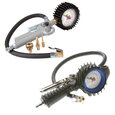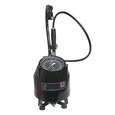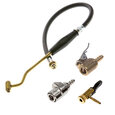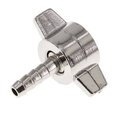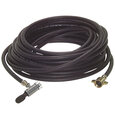Portable Car Tire Inflators
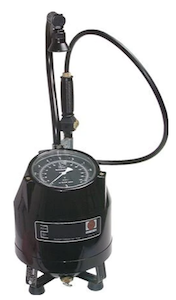
Figure 1: Portable car tire inflator
A portable tire inflator is a compact and lightweight device to inflate tires and various other inflatables on the go. It is a convenient and practical tool for motorists to maintain proper tire pressure and inflate tires during emergencies, travel, or outdoor activities. They are often referred to as portable air compressors or mini air inflators. This article explores the features of a portable car tire inflator, it's working, and selection criteria. Read our car inflator types article for more details on the various types of car inflators available for use.
Table of contents
View our online selection of tire inflators!
Advantages
- Portability and convenience: Portable tire inflators have a lightweight design making them easy to carry and store in vehicles or backpacks.
- Versatility: Portable tire inflators work on versatile power sources, such as 12-volt vehicle sockets or rechargeable batteries, allowing users to inflate tires and other inflatables in various locations, even where a fixed power source is unavailable.
- Emergency preparedness: A portable tire inflator in the vehicle helps prepare for unexpected flat tires or gradual pressure loss. It enables inflating tires on the spot and continuing the journey safely, eliminating the need for roadside assistance.
- Accuracy and control: Many portable inflators have built-in pressure gauges and digital displays, allowing for accurate pressure readings. This helps prevent over-inflation, which can negatively impact tire performance and longevity.
- Multi-functional: Some portable tire inflators offer additional features like built-in LED lights for nighttime use, preset pressure settings, and automatic shut-off, enhancing their usability and making them useful for various inflation needs beyond tires.
Types
Portable tire inflators are available in various forms, with handheld devices and console units being the two main types.
Handheld devices
For emergencies, a handheld tire inflator is best to keep in the car. It is compact and easy to use.
Console units
Console units are well-suited for everyday household and recreational inflation needs. They can inflate various items, such as car tires, sports balls, air mattresses for camping, rafts, toys, and SUPs for recreational activities like inflatable kayaks.
- Many console units offer power options, various inflation attachments, and additional features not found in handheld inflators. Some even come integrated with other tools, such as portable jump starters.
- However, handheld inflators are generally faster at inflating tires than console compressors.
- Although consoles are somewhat portable, they are not ideal for emergency car use as they are slightly impractical due to their large size and weight. Also, console units require setting up, connecting to a power source, and maneuvering hoses or attachments, which can be time-consuming and inconvenient in urgent scenarios.
Other types
Portable tire inflators are also available in other types, including 12-volt inflators that plug into a vehicle's cigarette lighter socket, rechargeable battery-powered inflators, and cordless models for increased portability.
Selecting a portable tire inflator
- Type: Choose a suitable tire inflator from the various options available (handheld vs console, corded vs cordless, and battery-powered vs rechargeable).
-
Power: Consider the power source options available.
- Opt for an alternative power source model, such as battery-powered handheld inflators with a backup 12-volt car plug. This ensures easy charging in case one power source fails.
- While wall plugs are suitable for top-ups at home, they may need the user to move the car closer to an electrical outlet or use a long extension cord. Alternatively, consider using a portable generator or battery pack for power. Some inflators come with direct-to-battery power sources, which provide maximum power but might be less practical as they are bulky.
-
Accessories and features: Portable tire inflators come with multiple features and accessories.
- An integrated work light that helps repair during dark roadside situations, with some models even functioning as emergency beacons.
- Choose a digital gauge with auto shut-off instead of analog dials for more accurate readings and convenience.
- Choose a tire inflator with clamp-style valve attachments, as they are easier and more practical than screw-on connectors.
- Look for rubber feet on the inflator to keep it stable and secure during operation.
Working principle
Activating the inflator switch powers up the motor, driving a piston that pressurizes and pumps air into the tire through the connector. The various parts in a portable tire inflator are as follows:
-
Power source: Most portable tire inflators can be powered in one of the following three ways:
- By plugging the inflator directly into a wall socket,
- Using the 12V cigarette lighter in the car (the universal choice for car drivers)
- Utilizing battery power
- Switch: The tire inflator's switch activates the motor. Essentially, the switch functions to turn the device on and off.
- Electric motor: The motor's output shaft is typically connected to gears that transfer energy to the piston. The output shaft may also connect to a fan that cools down the device while the motor runs.
- Gears: Most tire inflators have two gears: one connected to the motor and the other to the piston. As the motor moves, its gear meshes with the piston's gear, causing the piston to move. In some models, a third gear may also be present to drive a fan.
- Piston and cylinder: The piston plays a crucial role in the tire inflator's mechanism. As the gears turn, the piston is drawn down, allowing air to enter the cylinder through an intake. It is then pushed upward, compressing the air within the cylinder. This compressed air is pushed through the connecting tube into the tire, enabling continuous compression and air pumping.
- Fan: A small built-in fan ensures efficient air cooling in most tire inflators. The fan is usually positioned near the motor, where most heat is generated.
- Valves: Various valves, like ball and butterfly valves, control the airflow into the cylinder.
- Pressure sensor: Some tire inflators come equipped with a pressure sensor that reads the tire pressure and displays it on a digital gauge. Additionally, pressure sensors may control a valve automatically, allowing convenient automatic closing when the desired pressure level is reached.
- Connector: The connector, or the tubing at the end of the tire inflator, links the inflator to the tire, ball, or any other object that needs inflation. Crafted from rubber and sometimes covered with a fabric wrap, the connector provides added protection and durability. Modern tire inflator models often include a variety of tips that can be attached to the connector for versatile usage in various inflation needs.
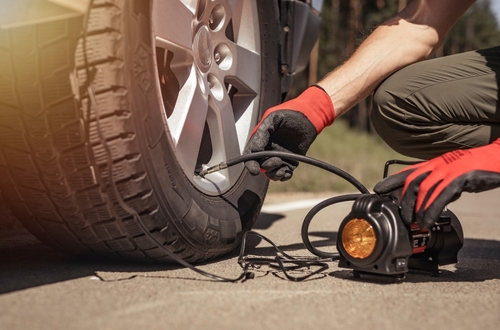
Figure 2: Using a portable car tire inflator
Disadvantages
- Lower PSI capacity: Portable tire inflators generally have a lower PSI (pressure) capacity than larger, stationary air compressors. While suitable for most car tires and small inflatables, they may not be ideal for heavy-duty tasks or large vehicle tires.
- Inflation time: Portable tire inflators may take longer to inflate tires compared to more powerful air compressors due to their smaller size and power output. This could be an issue when dealing with larger or multiple tires.
- Battery limitations: The battery life may be limited for rechargeable battery-powered inflators, especially in extreme weather conditions. Cold temperatures, for example, can affect battery efficiency and runtime.
- Noise and heat: Portable tire inflators can generate noise and heat during operation. While efforts are made to reduce noise levels, they may still be louder than some larger, quieter air compressors.
- Not suitable for heavy industrial use: Portable tire inflators are designed for individual use and may not be suitable for heavy industrial applications or continuous, high-volume inflation tasks.
- Limited sealant compatibility: Some portable inflators may not be compatible with tire sealants or foam cans used for temporary tire repairs. This limitation should be considered when planning for tire emergencies.
FAQs
Are portable tire inflators accurate?
Portable tire inflators with analog readouts may not be 100% accurate; inflators with digital displays are more dependable.
Does a tire inflator affect the car battery?
Directly using a tire inflator can draw power from the car battery. To avoid draining the battery, especially with extensive use, keep the engine running while using the inflator.




